SPSS Analysis of Advertising's Influence on Children in Lebanon
VerifiedAdded on 2021/02/20
|13
|2512
|105
Report
AI Summary
This report presents an SPSS analysis investigating the impact of advertising on children in Lebanon. The analysis explores three key objectives: parents' overall perceptions of advertising, the relationship between advertising exposure and materialism among children, and the connection between advertising exposure and parent-child conflict. The study utilizes regression and correlation analyses to examine variables such as the influence of ads on children's lifestyle desires, the link between materialism and pressure to buy products, and the association between government control of advertising and family values. The findings reveal insights into the correlation between TV viewing duration and children's materialistic tendencies and product comparisons, as well as the effect of children's desire for advertised products on parent-child relationships. The report concludes by highlighting the significant relationships and offering recommendations regarding advertising's potential impact on children.

SPSS Analysis
Paraphrase This Document
Need a fresh take? Get an instant paraphrase of this document with our AI Paraphraser

TABLE OF CONTENTS
Objective 1.......................................................................................................................................1
Objective 2.......................................................................................................................................6
Objective 3.......................................................................................................................................9
Objective 1.......................................................................................................................................1
Objective 2.......................................................................................................................................6
Objective 3.......................................................................................................................................9
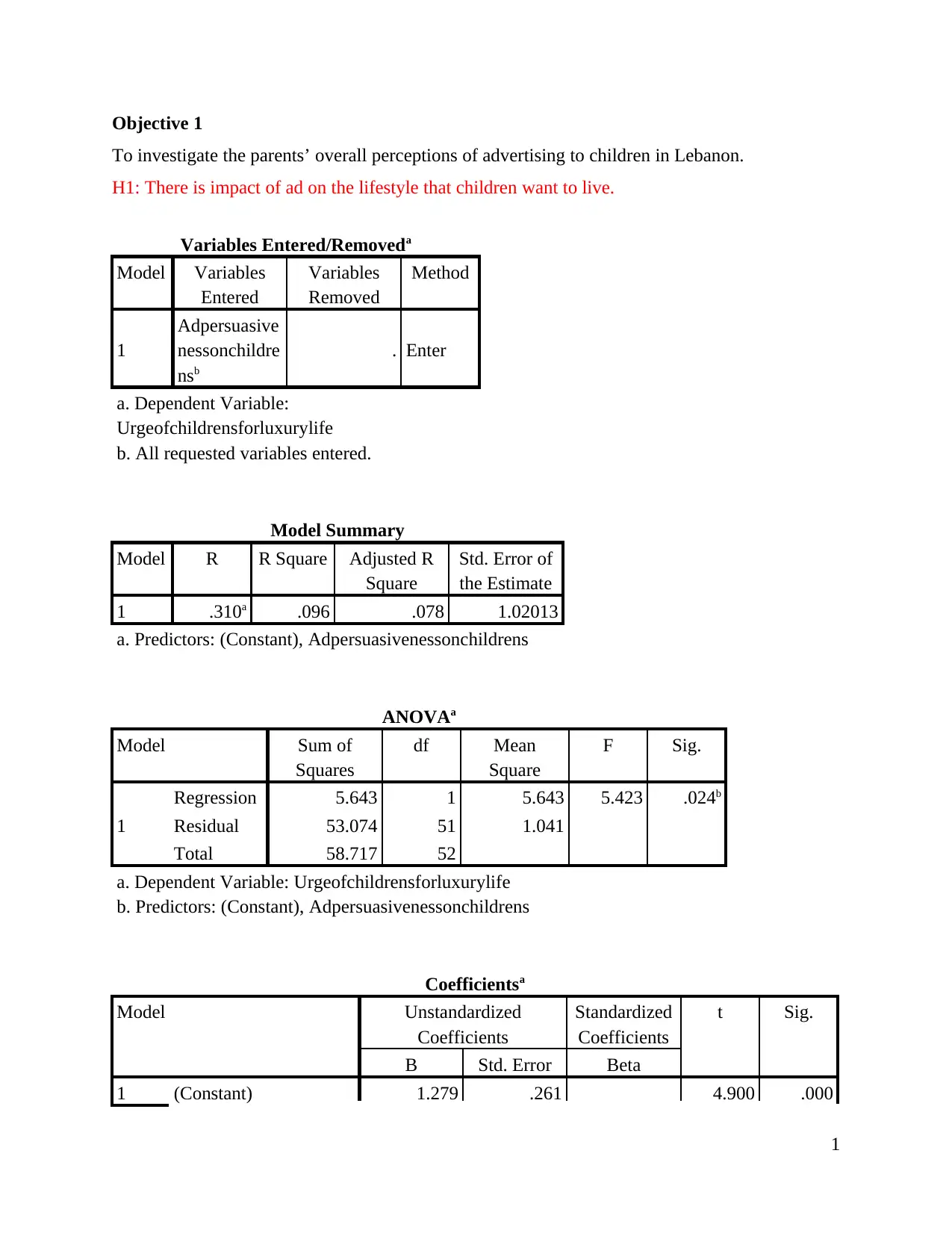
Objective 1
To investigate the parents’ overall perceptions of advertising to children in Lebanon.
H1: There is impact of ad on the lifestyle that children want to live.
Variables Entered/Removeda
Model Variables
Entered
Variables
Removed
Method
1
Adpersuasive
nessonchildre
nsb
. Enter
a. Dependent Variable:
Urgeofchildrensforluxurylife
b. All requested variables entered.
Model Summary
Model R R Square Adjusted R
Square
Std. Error of
the Estimate
1 .310a .096 .078 1.02013
a. Predictors: (Constant), Adpersuasivenessonchildrens
ANOVAa
Model Sum of
Squares
df Mean
Square
F Sig.
1
Regression 5.643 1 5.643 5.423 .024b
Residual 53.074 51 1.041
Total 58.717 52
a. Dependent Variable: Urgeofchildrensforluxurylife
b. Predictors: (Constant), Adpersuasivenessonchildrens
Coefficientsa
Model Unstandardized
Coefficients
Standardized
Coefficients
t Sig.
B Std. Error Beta
1 (Constant) 1.279 .261 4.900 .000
1
To investigate the parents’ overall perceptions of advertising to children in Lebanon.
H1: There is impact of ad on the lifestyle that children want to live.
Variables Entered/Removeda
Model Variables
Entered
Variables
Removed
Method
1
Adpersuasive
nessonchildre
nsb
. Enter
a. Dependent Variable:
Urgeofchildrensforluxurylife
b. All requested variables entered.
Model Summary
Model R R Square Adjusted R
Square
Std. Error of
the Estimate
1 .310a .096 .078 1.02013
a. Predictors: (Constant), Adpersuasivenessonchildrens
ANOVAa
Model Sum of
Squares
df Mean
Square
F Sig.
1
Regression 5.643 1 5.643 5.423 .024b
Residual 53.074 51 1.041
Total 58.717 52
a. Dependent Variable: Urgeofchildrensforluxurylife
b. Predictors: (Constant), Adpersuasivenessonchildrens
Coefficientsa
Model Unstandardized
Coefficients
Standardized
Coefficients
t Sig.
B Std. Error Beta
1 (Constant) 1.279 .261 4.900 .000
1
⊘ This is a preview!⊘
Do you want full access?
Subscribe today to unlock all pages.

Trusted by 1+ million students worldwide
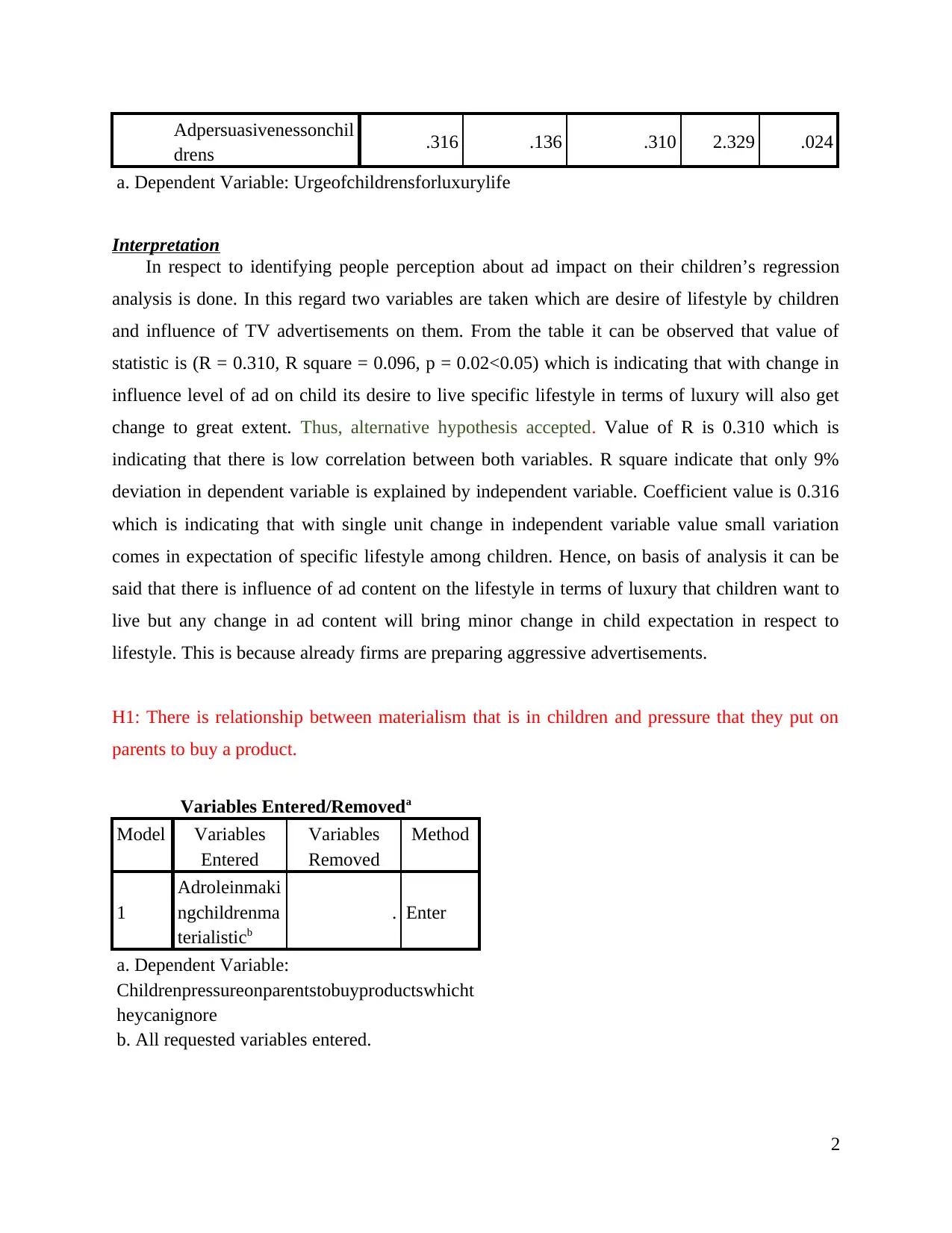
Adpersuasivenessonchil
drens .316 .136 .310 2.329 .024
a. Dependent Variable: Urgeofchildrensforluxurylife
Interpretation
In respect to identifying people perception about ad impact on their children’s regression
analysis is done. In this regard two variables are taken which are desire of lifestyle by children
and influence of TV advertisements on them. From the table it can be observed that value of
statistic is (R = 0.310, R square = 0.096, p = 0.02<0.05) which is indicating that with change in
influence level of ad on child its desire to live specific lifestyle in terms of luxury will also get
change to great extent. Thus, alternative hypothesis accepted. Value of R is 0.310 which is
indicating that there is low correlation between both variables. R square indicate that only 9%
deviation in dependent variable is explained by independent variable. Coefficient value is 0.316
which is indicating that with single unit change in independent variable value small variation
comes in expectation of specific lifestyle among children. Hence, on basis of analysis it can be
said that there is influence of ad content on the lifestyle in terms of luxury that children want to
live but any change in ad content will bring minor change in child expectation in respect to
lifestyle. This is because already firms are preparing aggressive advertisements.
H1: There is relationship between materialism that is in children and pressure that they put on
parents to buy a product.
Variables Entered/Removeda
Model Variables
Entered
Variables
Removed
Method
1
Adroleinmaki
ngchildrenma
terialisticb
. Enter
a. Dependent Variable:
Childrenpressureonparentstobuyproductswhicht
heycanignore
b. All requested variables entered.
2
drens .316 .136 .310 2.329 .024
a. Dependent Variable: Urgeofchildrensforluxurylife
Interpretation
In respect to identifying people perception about ad impact on their children’s regression
analysis is done. In this regard two variables are taken which are desire of lifestyle by children
and influence of TV advertisements on them. From the table it can be observed that value of
statistic is (R = 0.310, R square = 0.096, p = 0.02<0.05) which is indicating that with change in
influence level of ad on child its desire to live specific lifestyle in terms of luxury will also get
change to great extent. Thus, alternative hypothesis accepted. Value of R is 0.310 which is
indicating that there is low correlation between both variables. R square indicate that only 9%
deviation in dependent variable is explained by independent variable. Coefficient value is 0.316
which is indicating that with single unit change in independent variable value small variation
comes in expectation of specific lifestyle among children. Hence, on basis of analysis it can be
said that there is influence of ad content on the lifestyle in terms of luxury that children want to
live but any change in ad content will bring minor change in child expectation in respect to
lifestyle. This is because already firms are preparing aggressive advertisements.
H1: There is relationship between materialism that is in children and pressure that they put on
parents to buy a product.
Variables Entered/Removeda
Model Variables
Entered
Variables
Removed
Method
1
Adroleinmaki
ngchildrenma
terialisticb
. Enter
a. Dependent Variable:
Childrenpressureonparentstobuyproductswhicht
heycanignore
b. All requested variables entered.
2
Paraphrase This Document
Need a fresh take? Get an instant paraphrase of this document with our AI Paraphraser
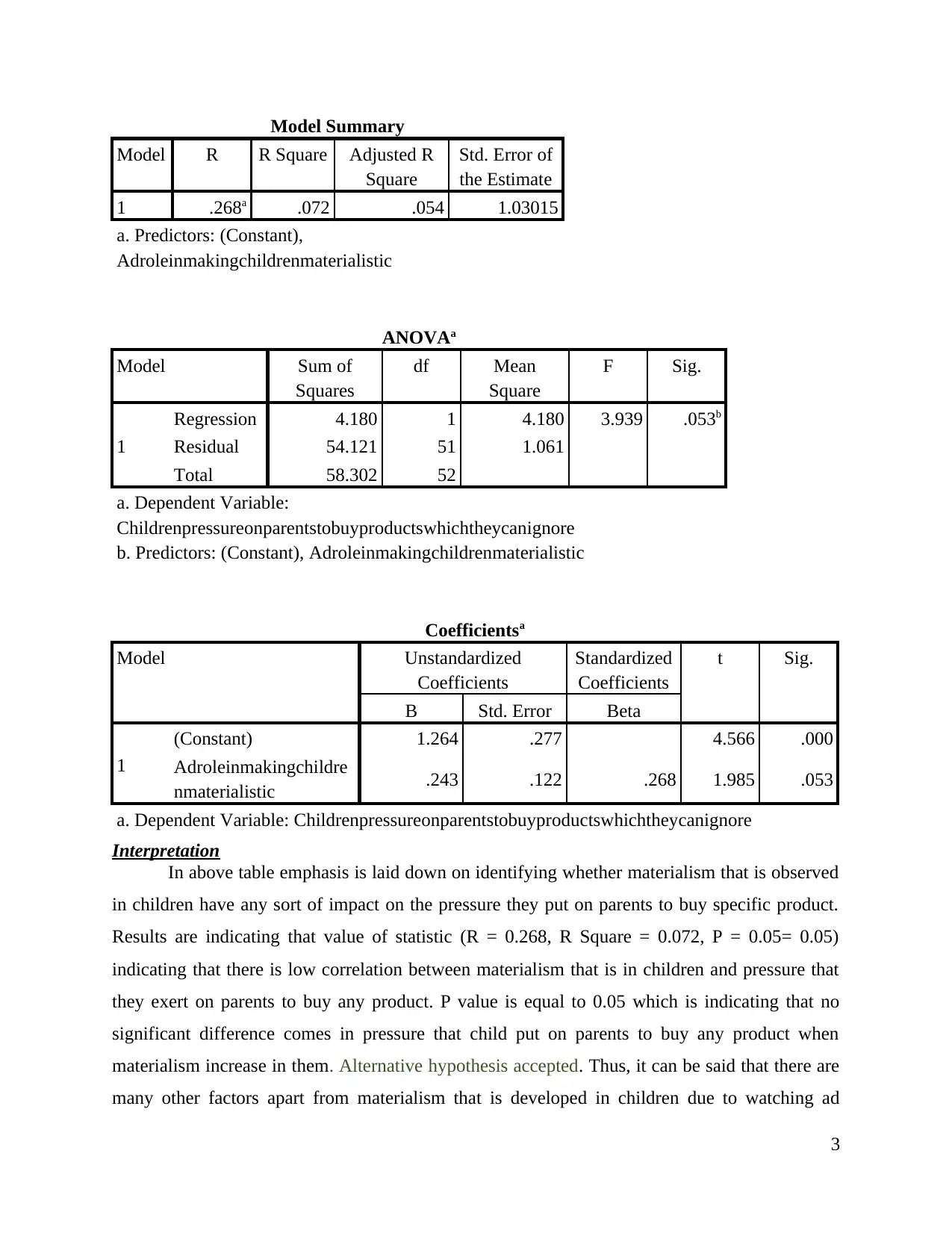
Model Summary
Model R R Square Adjusted R
Square
Std. Error of
the Estimate
1 .268a .072 .054 1.03015
a. Predictors: (Constant),
Adroleinmakingchildrenmaterialistic
ANOVAa
Model Sum of
Squares
df Mean
Square
F Sig.
1
Regression 4.180 1 4.180 3.939 .053b
Residual 54.121 51 1.061
Total 58.302 52
a. Dependent Variable:
Childrenpressureonparentstobuyproductswhichtheycanignore
b. Predictors: (Constant), Adroleinmakingchildrenmaterialistic
Coefficientsa
Model Unstandardized
Coefficients
Standardized
Coefficients
t Sig.
B Std. Error Beta
1
(Constant) 1.264 .277 4.566 .000
Adroleinmakingchildre
nmaterialistic .243 .122 .268 1.985 .053
a. Dependent Variable: Childrenpressureonparentstobuyproductswhichtheycanignore
Interpretation
In above table emphasis is laid down on identifying whether materialism that is observed
in children have any sort of impact on the pressure they put on parents to buy specific product.
Results are indicating that value of statistic (R = 0.268, R Square = 0.072, P = 0.05= 0.05)
indicating that there is low correlation between materialism that is in children and pressure that
they exert on parents to buy any product. P value is equal to 0.05 which is indicating that no
significant difference comes in pressure that child put on parents to buy any product when
materialism increase in them. Alternative hypothesis accepted. Thus, it can be said that there are
many other factors apart from materialism that is developed in children due to watching ad
3
Model R R Square Adjusted R
Square
Std. Error of
the Estimate
1 .268a .072 .054 1.03015
a. Predictors: (Constant),
Adroleinmakingchildrenmaterialistic
ANOVAa
Model Sum of
Squares
df Mean
Square
F Sig.
1
Regression 4.180 1 4.180 3.939 .053b
Residual 54.121 51 1.061
Total 58.302 52
a. Dependent Variable:
Childrenpressureonparentstobuyproductswhichtheycanignore
b. Predictors: (Constant), Adroleinmakingchildrenmaterialistic
Coefficientsa
Model Unstandardized
Coefficients
Standardized
Coefficients
t Sig.
B Std. Error Beta
1
(Constant) 1.264 .277 4.566 .000
Adroleinmakingchildre
nmaterialistic .243 .122 .268 1.985 .053
a. Dependent Variable: Childrenpressureonparentstobuyproductswhichtheycanignore
Interpretation
In above table emphasis is laid down on identifying whether materialism that is observed
in children have any sort of impact on the pressure they put on parents to buy specific product.
Results are indicating that value of statistic (R = 0.268, R Square = 0.072, P = 0.05= 0.05)
indicating that there is low correlation between materialism that is in children and pressure that
they exert on parents to buy any product. P value is equal to 0.05 which is indicating that no
significant difference comes in pressure that child put on parents to buy any product when
materialism increase in them. Alternative hypothesis accepted. Thus, it can be said that there are
many other factors apart from materialism that is developed in children due to watching ad
3

which lead to pressure that children put on parents to buy any specific product. Thus, it can be
concluded that parents must not think that there is only advertisements due to which their
children are demanding any specific item from them.
H1: There is relationship between people demand for government to control advertisement and
destruction of family values that is done by advertisement.
Correlations
Thereshouldb
eastrictgover
nmentcontrol
onTVadvertis
mentinLeban
on
TVAdandcon
tradictiontofa
milyvalues
Thereshouldbeastrictgo
vernmentcontrolonTVa
dvertismentinLebanon
Pearson
Correlation 1 .273*
Sig. (2-tailed) .048
N 53 53
TVAdandcontradictiont
ofamilyvalues
Pearson
Correlation .273* 1
Sig. (2-tailed) .048
N 53 53
*. Correlation is significant at the 0.05 level (2-tailed).
Interpretation
Correlation value is 0.27 which indicate positive relationship between both variables.
This value also reflects that relationship between both variables is weak. Means that only to
some extent parents think that because advertisements are presenting products in such a way that
is against their family values government must control advertisement. However, value of level of
significance is P = 0.04<0.05 which is indicating that there is significant association between
both variables. Hence, alternative hypothesis accepted. It can be said that there are few people
who have common assumption that whatever is advertised on TV have negative impact on
children brain and their thinking. Such kind of things may lead to origination of any criminal act.
Hence, it can be said that such kind of concern of parents is right on their place.
4
concluded that parents must not think that there is only advertisements due to which their
children are demanding any specific item from them.
H1: There is relationship between people demand for government to control advertisement and
destruction of family values that is done by advertisement.
Correlations
Thereshouldb
eastrictgover
nmentcontrol
onTVadvertis
mentinLeban
on
TVAdandcon
tradictiontofa
milyvalues
Thereshouldbeastrictgo
vernmentcontrolonTVa
dvertismentinLebanon
Pearson
Correlation 1 .273*
Sig. (2-tailed) .048
N 53 53
TVAdandcontradictiont
ofamilyvalues
Pearson
Correlation .273* 1
Sig. (2-tailed) .048
N 53 53
*. Correlation is significant at the 0.05 level (2-tailed).
Interpretation
Correlation value is 0.27 which indicate positive relationship between both variables.
This value also reflects that relationship between both variables is weak. Means that only to
some extent parents think that because advertisements are presenting products in such a way that
is against their family values government must control advertisement. However, value of level of
significance is P = 0.04<0.05 which is indicating that there is significant association between
both variables. Hence, alternative hypothesis accepted. It can be said that there are few people
who have common assumption that whatever is advertised on TV have negative impact on
children brain and their thinking. Such kind of things may lead to origination of any criminal act.
Hence, it can be said that such kind of concern of parents is right on their place.
4
⊘ This is a preview!⊘
Do you want full access?
Subscribe today to unlock all pages.

Trusted by 1+ million students worldwide
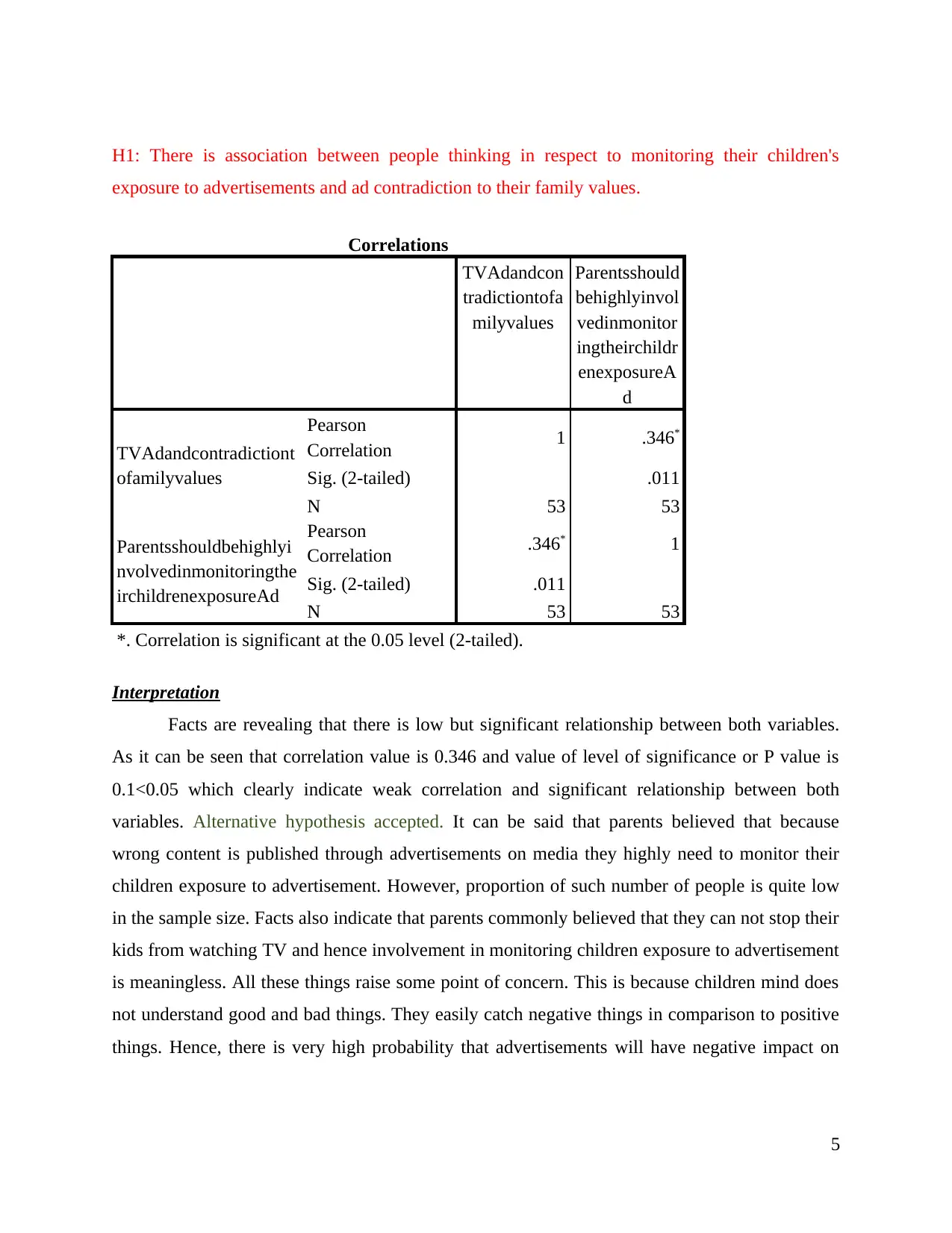
H1: There is association between people thinking in respect to monitoring their children's
exposure to advertisements and ad contradiction to their family values.
Correlations
TVAdandcon
tradictiontofa
milyvalues
Parentsshould
behighlyinvol
vedinmonitor
ingtheirchildr
enexposureA
d
TVAdandcontradictiont
ofamilyvalues
Pearson
Correlation 1 .346*
Sig. (2-tailed) .011
N 53 53
Parentsshouldbehighlyi
nvolvedinmonitoringthe
irchildrenexposureAd
Pearson
Correlation .346* 1
Sig. (2-tailed) .011
N 53 53
*. Correlation is significant at the 0.05 level (2-tailed).
Interpretation
Facts are revealing that there is low but significant relationship between both variables.
As it can be seen that correlation value is 0.346 and value of level of significance or P value is
0.1<0.05 which clearly indicate weak correlation and significant relationship between both
variables. Alternative hypothesis accepted. It can be said that parents believed that because
wrong content is published through advertisements on media they highly need to monitor their
children exposure to advertisement. However, proportion of such number of people is quite low
in the sample size. Facts also indicate that parents commonly believed that they can not stop their
kids from watching TV and hence involvement in monitoring children exposure to advertisement
is meaningless. All these things raise some point of concern. This is because children mind does
not understand good and bad things. They easily catch negative things in comparison to positive
things. Hence, there is very high probability that advertisements will have negative impact on
5
exposure to advertisements and ad contradiction to their family values.
Correlations
TVAdandcon
tradictiontofa
milyvalues
Parentsshould
behighlyinvol
vedinmonitor
ingtheirchildr
enexposureA
d
TVAdandcontradictiont
ofamilyvalues
Pearson
Correlation 1 .346*
Sig. (2-tailed) .011
N 53 53
Parentsshouldbehighlyi
nvolvedinmonitoringthe
irchildrenexposureAd
Pearson
Correlation .346* 1
Sig. (2-tailed) .011
N 53 53
*. Correlation is significant at the 0.05 level (2-tailed).
Interpretation
Facts are revealing that there is low but significant relationship between both variables.
As it can be seen that correlation value is 0.346 and value of level of significance or P value is
0.1<0.05 which clearly indicate weak correlation and significant relationship between both
variables. Alternative hypothesis accepted. It can be said that parents believed that because
wrong content is published through advertisements on media they highly need to monitor their
children exposure to advertisement. However, proportion of such number of people is quite low
in the sample size. Facts also indicate that parents commonly believed that they can not stop their
kids from watching TV and hence involvement in monitoring children exposure to advertisement
is meaningless. All these things raise some point of concern. This is because children mind does
not understand good and bad things. They easily catch negative things in comparison to positive
things. Hence, there is very high probability that advertisements will have negative impact on
5
Paraphrase This Document
Need a fresh take? Get an instant paraphrase of this document with our AI Paraphraser

children brain. There is need to take strong steps to ensure that advertisement cause limited or no
damage to the thinking of children.
Objective 2
To investigate the relationship between advertising exposure and materialism among children in
Lebanon.
H1: There is impact of duration for which child watch TV to their thinking that it is important to
acquire lots of things.
Variables Entered/Removeda
Model Variables
Entered
Variables
Removed
Method
1 Timespendby
childonTVb . Enter
a. Dependent Variable:
Doesyourchildthinkitisimportanttoownalotofthi
ngs
b. All requested variables entered.
Model Summary
Model R R Square Adjusted R
Square
Std. Error of
the Estimate
1 .277a .077 .058 .95151
a. Predictors: (Constant), TimespendbychildonTV
ANOVAa
Model Sum of
Squares
df Mean
Square
F Sig.
1
Regression 3.676 1 3.676 4.060 .049b
Residual 44.364 49 .905
Total 48.039 50
6
damage to the thinking of children.
Objective 2
To investigate the relationship between advertising exposure and materialism among children in
Lebanon.
H1: There is impact of duration for which child watch TV to their thinking that it is important to
acquire lots of things.
Variables Entered/Removeda
Model Variables
Entered
Variables
Removed
Method
1 Timespendby
childonTVb . Enter
a. Dependent Variable:
Doesyourchildthinkitisimportanttoownalotofthi
ngs
b. All requested variables entered.
Model Summary
Model R R Square Adjusted R
Square
Std. Error of
the Estimate
1 .277a .077 .058 .95151
a. Predictors: (Constant), TimespendbychildonTV
ANOVAa
Model Sum of
Squares
df Mean
Square
F Sig.
1
Regression 3.676 1 3.676 4.060 .049b
Residual 44.364 49 .905
Total 48.039 50
6

a. Dependent Variable: Doesyourchildthinkitisimportanttoownalotofthings
b. Predictors: (Constant), TimespendbychildonTV
Coefficientsa
Model Unstandardized
Coefficients
Standardized
Coefficients
t Sig.
B Std. Error Beta
1
(Constant) 2.019 .171 11.831 .000
Timespendbychildon
TV -.020 .010 -.277 -2.015 .049
a. Dependent Variable: Doesyourchildthinkitisimportanttoownalotofthings
Interpretation
Facts are indicating that value of statistic is (R = 0.277, R square = 0.077, P =
0.049<0.05) which reflect that there is very low correlation between dependent and independent
variables. In above table dependent and independent variables are children thinking to have lots
of things and times they spend on TV. On basis of P value, it can be said that there is significant
difference between both independent and dependent variables. However, there is low correlation
between both of them and only small percentage which is 7% variation in dependent variable is
explained by independent variable. Hence, it can be said that children intention to have lots of
things is not only caused just be watching advertisement’s. Alternative hypothesis accepted.
There may be many other reasons like such kind of intention may comes in existence in mind of
child because it see large number of items on its friend’s homes etc. This does not mean that
watching TV for long is not having any impact on such kind of desires that is tested in children
through analysis given above. Watching TV for long time is also having impact on children
desire to have lot of things at their home but still there are many other factors that collectively
have impact on such kind of desire among children.
H1: There is impact of duration for which child watch TV and comparisons that they made to
their friends in respect to possession of items.
7
b. Predictors: (Constant), TimespendbychildonTV
Coefficientsa
Model Unstandardized
Coefficients
Standardized
Coefficients
t Sig.
B Std. Error Beta
1
(Constant) 2.019 .171 11.831 .000
Timespendbychildon
TV -.020 .010 -.277 -2.015 .049
a. Dependent Variable: Doesyourchildthinkitisimportanttoownalotofthings
Interpretation
Facts are indicating that value of statistic is (R = 0.277, R square = 0.077, P =
0.049<0.05) which reflect that there is very low correlation between dependent and independent
variables. In above table dependent and independent variables are children thinking to have lots
of things and times they spend on TV. On basis of P value, it can be said that there is significant
difference between both independent and dependent variables. However, there is low correlation
between both of them and only small percentage which is 7% variation in dependent variable is
explained by independent variable. Hence, it can be said that children intention to have lots of
things is not only caused just be watching advertisement’s. Alternative hypothesis accepted.
There may be many other reasons like such kind of intention may comes in existence in mind of
child because it see large number of items on its friend’s homes etc. This does not mean that
watching TV for long is not having any impact on such kind of desires that is tested in children
through analysis given above. Watching TV for long time is also having impact on children
desire to have lot of things at their home but still there are many other factors that collectively
have impact on such kind of desire among children.
H1: There is impact of duration for which child watch TV and comparisons that they made to
their friends in respect to possession of items.
7
⊘ This is a preview!⊘
Do you want full access?
Subscribe today to unlock all pages.

Trusted by 1+ million students worldwide
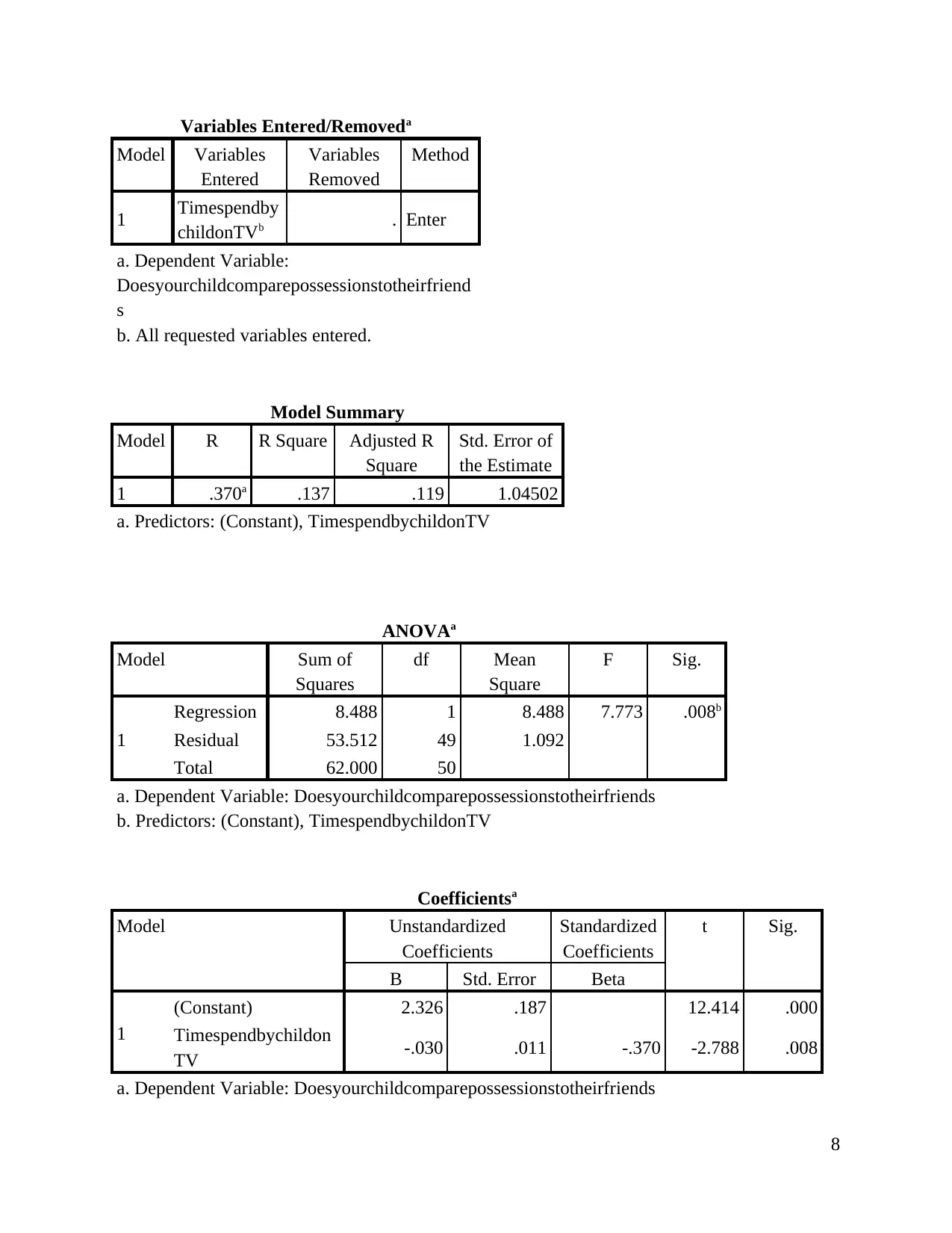
Variables Entered/Removeda
Model Variables
Entered
Variables
Removed
Method
1 Timespendby
childonTVb . Enter
a. Dependent Variable:
Doesyourchildcomparepossessionstotheirfriend
s
b. All requested variables entered.
Model Summary
Model R R Square Adjusted R
Square
Std. Error of
the Estimate
1 .370a .137 .119 1.04502
a. Predictors: (Constant), TimespendbychildonTV
ANOVAa
Model Sum of
Squares
df Mean
Square
F Sig.
1
Regression 8.488 1 8.488 7.773 .008b
Residual 53.512 49 1.092
Total 62.000 50
a. Dependent Variable: Doesyourchildcomparepossessionstotheirfriends
b. Predictors: (Constant), TimespendbychildonTV
Coefficientsa
Model Unstandardized
Coefficients
Standardized
Coefficients
t Sig.
B Std. Error Beta
1
(Constant) 2.326 .187 12.414 .000
Timespendbychildon
TV -.030 .011 -.370 -2.788 .008
a. Dependent Variable: Doesyourchildcomparepossessionstotheirfriends
8
Model Variables
Entered
Variables
Removed
Method
1 Timespendby
childonTVb . Enter
a. Dependent Variable:
Doesyourchildcomparepossessionstotheirfriend
s
b. All requested variables entered.
Model Summary
Model R R Square Adjusted R
Square
Std. Error of
the Estimate
1 .370a .137 .119 1.04502
a. Predictors: (Constant), TimespendbychildonTV
ANOVAa
Model Sum of
Squares
df Mean
Square
F Sig.
1
Regression 8.488 1 8.488 7.773 .008b
Residual 53.512 49 1.092
Total 62.000 50
a. Dependent Variable: Doesyourchildcomparepossessionstotheirfriends
b. Predictors: (Constant), TimespendbychildonTV
Coefficientsa
Model Unstandardized
Coefficients
Standardized
Coefficients
t Sig.
B Std. Error Beta
1
(Constant) 2.326 .187 12.414 .000
Timespendbychildon
TV -.030 .011 -.370 -2.788 .008
a. Dependent Variable: Doesyourchildcomparepossessionstotheirfriends
8
Paraphrase This Document
Need a fresh take? Get an instant paraphrase of this document with our AI Paraphraser
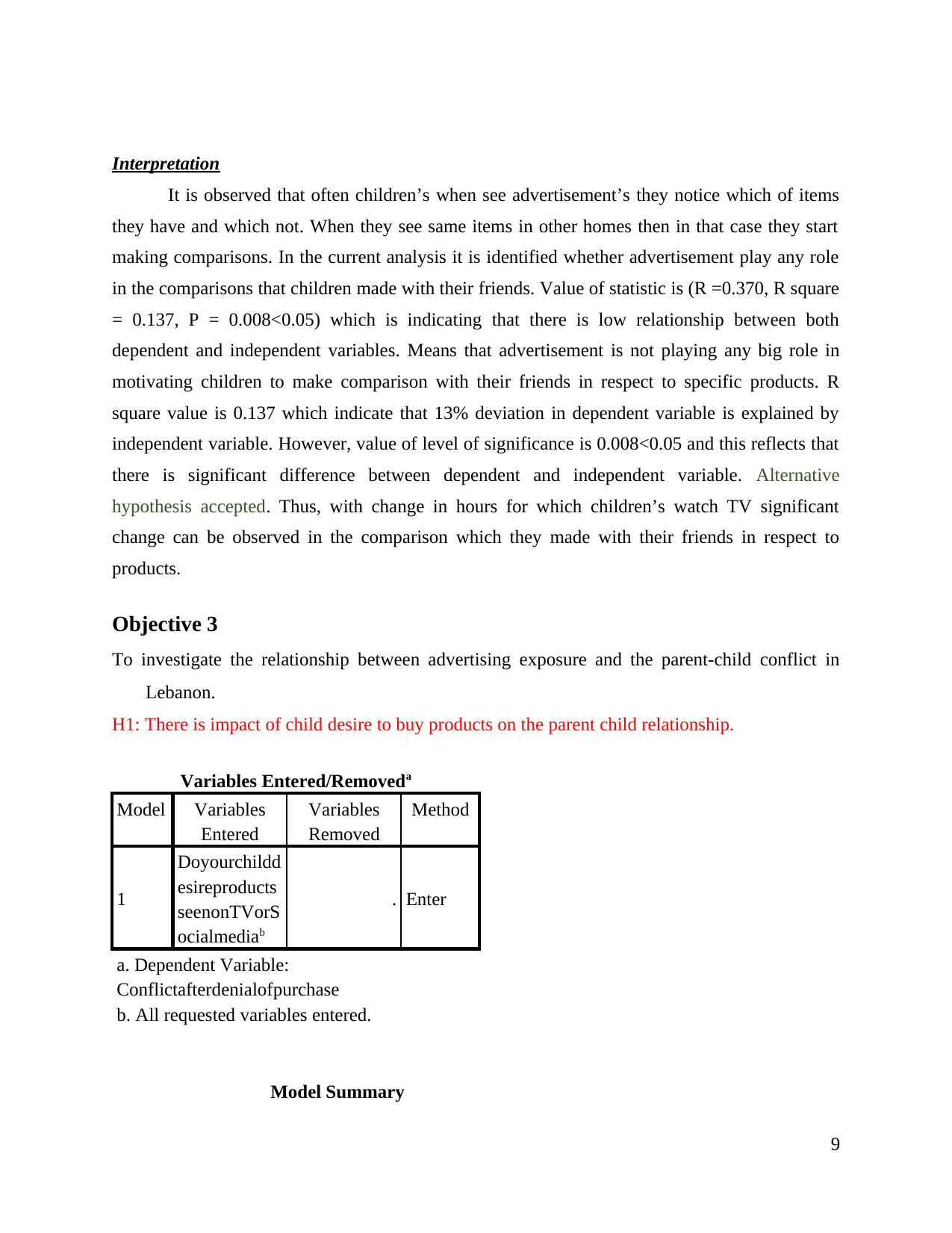
Interpretation
It is observed that often children’s when see advertisement’s they notice which of items
they have and which not. When they see same items in other homes then in that case they start
making comparisons. In the current analysis it is identified whether advertisement play any role
in the comparisons that children made with their friends. Value of statistic is (R =0.370, R square
= 0.137, P = 0.008<0.05) which is indicating that there is low relationship between both
dependent and independent variables. Means that advertisement is not playing any big role in
motivating children to make comparison with their friends in respect to specific products. R
square value is 0.137 which indicate that 13% deviation in dependent variable is explained by
independent variable. However, value of level of significance is 0.008<0.05 and this reflects that
there is significant difference between dependent and independent variable. Alternative
hypothesis accepted. Thus, with change in hours for which children’s watch TV significant
change can be observed in the comparison which they made with their friends in respect to
products.
Objective 3
To investigate the relationship between advertising exposure and the parent-child conflict in
Lebanon.
H1: There is impact of child desire to buy products on the parent child relationship.
Variables Entered/Removeda
Model Variables
Entered
Variables
Removed
Method
1
Doyourchildd
esireproducts
seenonTVorS
ocialmediab
. Enter
a. Dependent Variable:
Conflictafterdenialofpurchase
b. All requested variables entered.
Model Summary
9
It is observed that often children’s when see advertisement’s they notice which of items
they have and which not. When they see same items in other homes then in that case they start
making comparisons. In the current analysis it is identified whether advertisement play any role
in the comparisons that children made with their friends. Value of statistic is (R =0.370, R square
= 0.137, P = 0.008<0.05) which is indicating that there is low relationship between both
dependent and independent variables. Means that advertisement is not playing any big role in
motivating children to make comparison with their friends in respect to specific products. R
square value is 0.137 which indicate that 13% deviation in dependent variable is explained by
independent variable. However, value of level of significance is 0.008<0.05 and this reflects that
there is significant difference between dependent and independent variable. Alternative
hypothesis accepted. Thus, with change in hours for which children’s watch TV significant
change can be observed in the comparison which they made with their friends in respect to
products.
Objective 3
To investigate the relationship between advertising exposure and the parent-child conflict in
Lebanon.
H1: There is impact of child desire to buy products on the parent child relationship.
Variables Entered/Removeda
Model Variables
Entered
Variables
Removed
Method
1
Doyourchildd
esireproducts
seenonTVorS
ocialmediab
. Enter
a. Dependent Variable:
Conflictafterdenialofpurchase
b. All requested variables entered.
Model Summary
9
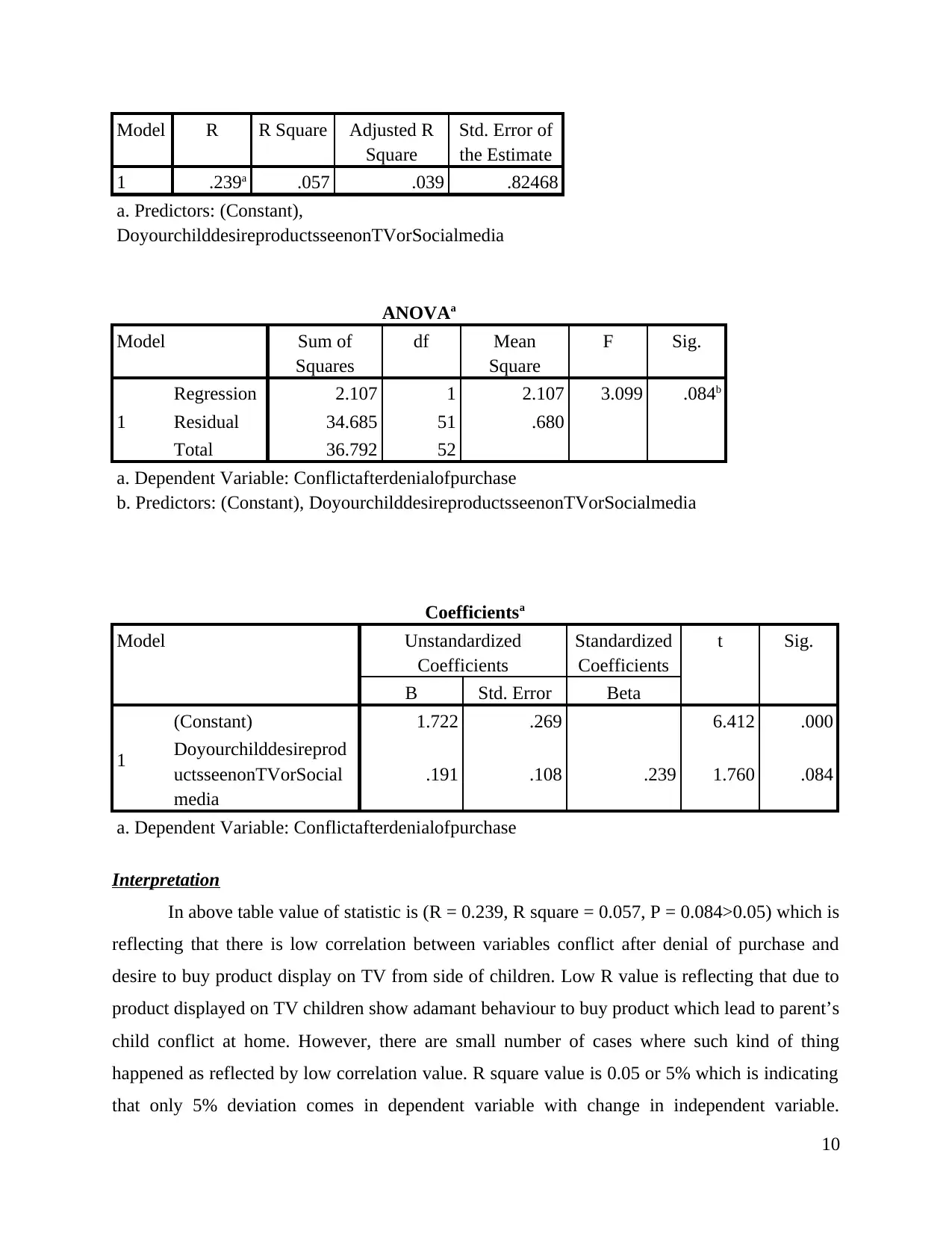
Model R R Square Adjusted R
Square
Std. Error of
the Estimate
1 .239a .057 .039 .82468
a. Predictors: (Constant),
DoyourchilddesireproductsseenonTVorSocialmedia
ANOVAa
Model Sum of
Squares
df Mean
Square
F Sig.
1
Regression 2.107 1 2.107 3.099 .084b
Residual 34.685 51 .680
Total 36.792 52
a. Dependent Variable: Conflictafterdenialofpurchase
b. Predictors: (Constant), DoyourchilddesireproductsseenonTVorSocialmedia
Coefficientsa
Model Unstandardized
Coefficients
Standardized
Coefficients
t Sig.
B Std. Error Beta
1
(Constant) 1.722 .269 6.412 .000
Doyourchilddesireprod
uctsseenonTVorSocial
media
.191 .108 .239 1.760 .084
a. Dependent Variable: Conflictafterdenialofpurchase
Interpretation
In above table value of statistic is (R = 0.239, R square = 0.057, P = 0.084>0.05) which is
reflecting that there is low correlation between variables conflict after denial of purchase and
desire to buy product display on TV from side of children. Low R value is reflecting that due to
product displayed on TV children show adamant behaviour to buy product which lead to parent’s
child conflict at home. However, there are small number of cases where such kind of thing
happened as reflected by low correlation value. R square value is 0.05 or 5% which is indicating
that only 5% deviation comes in dependent variable with change in independent variable.
10
Square
Std. Error of
the Estimate
1 .239a .057 .039 .82468
a. Predictors: (Constant),
DoyourchilddesireproductsseenonTVorSocialmedia
ANOVAa
Model Sum of
Squares
df Mean
Square
F Sig.
1
Regression 2.107 1 2.107 3.099 .084b
Residual 34.685 51 .680
Total 36.792 52
a. Dependent Variable: Conflictafterdenialofpurchase
b. Predictors: (Constant), DoyourchilddesireproductsseenonTVorSocialmedia
Coefficientsa
Model Unstandardized
Coefficients
Standardized
Coefficients
t Sig.
B Std. Error Beta
1
(Constant) 1.722 .269 6.412 .000
Doyourchilddesireprod
uctsseenonTVorSocial
media
.191 .108 .239 1.760 .084
a. Dependent Variable: Conflictafterdenialofpurchase
Interpretation
In above table value of statistic is (R = 0.239, R square = 0.057, P = 0.084>0.05) which is
reflecting that there is low correlation between variables conflict after denial of purchase and
desire to buy product display on TV from side of children. Low R value is reflecting that due to
product displayed on TV children show adamant behaviour to buy product which lead to parent’s
child conflict at home. However, there are small number of cases where such kind of thing
happened as reflected by low correlation value. R square value is 0.05 or 5% which is indicating
that only 5% deviation comes in dependent variable with change in independent variable.
10
⊘ This is a preview!⊘
Do you want full access?
Subscribe today to unlock all pages.

Trusted by 1+ million students worldwide
1 out of 13
Related Documents
Your All-in-One AI-Powered Toolkit for Academic Success.
+13062052269
info@desklib.com
Available 24*7 on WhatsApp / Email
![[object Object]](/_next/static/media/star-bottom.7253800d.svg)
Unlock your academic potential
Copyright © 2020–2025 A2Z Services. All Rights Reserved. Developed and managed by ZUCOL.





